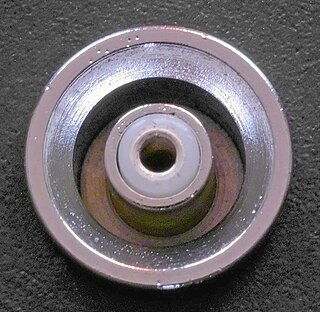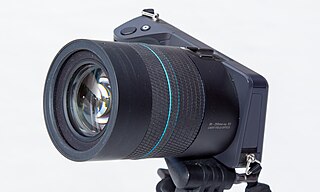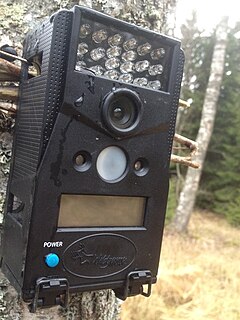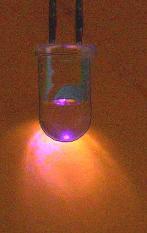
A single-lens reflex camera (SLR) is a camera that typically uses a mirror and prism system that permits the photographer to view through the lens and see exactly what will be captured. With twin lens reflex and rangefinder cameras, the viewed image could be significantly different from the final image. When the shutter button is pressed on most SLRs, the mirror flips out of the light path, allowing light to pass through to the light receptor and the image to be captured.

A digital camera or digicam is a camera that captures photographs in digital memory. Most cameras produced today are digital, and while there are still dedicated digital cameras, many more cameras are now being incorporated into mobile devices, portable touchscreen computers, which can, among many other purposes, use their cameras to initiate live videotelephony and directly edit and upload imagery to others. However, high-end, high-definition dedicated cameras are still commonly used by professionals.

A flash is a device used in photography producing a flash of artificial light at a color temperature of about 5500 K to help illuminate a scene. A major purpose of a flash is to illuminate a dark scene. Other uses are capturing quickly moving objects or changing the quality of light. Flash refers either to the flash of light itself or to the electronic flash unit discharging the light. Most current flash units are electronic, having evolved from single-use flashbulbs and flammable powders. Modern cameras often activate flash units automatically.

In a camera, flash synchronization is defined as synchronizing the firing of a photographic flash with the opening of the shutter admitting light to photographic film or electronic image sensor. It is often shortened to flash sync or flash synch.

Macro photography, is extreme close-up photography, usually of very small subjects and living organisms like insects, in which the size of the subject in the photograph is greater than life size .
By the original definition, a macro photograph is one in which the size of the subject on the negative or image sensor is life size or greater. However, in some uses it refers to a finished photograph of a subject at greater than life size.

An autofocus optical system uses a sensor, a control system and a motor to focus on an automatically or manually selected point or area. An electronic rangefinder has a display instead of the motor; the adjustment of the optical system has to be done manually until indication. Autofocus methods are distinguished by their type as being either active, passive or hybrid variants.
In photography, stopping down refers to increasing the numerical f-stop number, which decreases the size (diameter) of the aperture of a lens, resulting in reducing the amount of light entering the iris of a lens.

A point-and-shoot camera, also known as a compact camera and sometimes abbreviated to P&S, is a still camera designed primarily for simple operation. Most use focus free lenses or autofocus for focusing, automatic systems for setting the exposure options, and have flash units built in.

Cyber-shot is Sony's line of point-and-shoot digital cameras introduced in 1996. Cyber-shot model names use a DSC prefix, which is an initialism for "Digital Still Camera". Many Cyber-shot models feature Carl Zeiss trademarked lenses, while others use Sony, or Sony G lenses.
In photography, through-the-lens (TTL) metering refers to a feature of cameras whereby the intensity of light reflected from the scene is measured through the lens; as opposed to using a separate metering window or external hand-held light meter. In some cameras various TTL metering modes can be selected. This information can then be used to set the optimal film or image sensor exposure, it can also be used to control the amount of light emitted by a flash unit connected to the camera.
Canon's EOS flash system refers to the photographic flash mechanism used on Canon's film or digital EOS single-lens reflex cameras. The line was first introduced in 1987. It has gone through a number of revisions over the years, as new flash exposure metering systems have been introduced. The main light-metering technologies are known as A-TTL, E-TTL, and E-TTL II.

The EasyShare P880 was a high-end bridge digital camera from Kodak. It was announced August 2, 2005, within the Performance series. Its siblings are the P850 and the P712. The P880, however, possesses the largest optical sensor of all three models, with a size of 1/1.8 inches. Distinguishing features include a wide-angle coverage of 24 mm, on screen histogram display, and manual focus-by-wire. In terms of the Kodak product line and price the Performance series are the most sophisticated EasyShare cameras, just below the considerably more expensive Kodak professional DCS pro SLR digital cameras that were discontinued in May 2005.

A light field camera, also known as plenoptic camera, captures information about the light field emanating from a scene; that is, the intensity of light in a scene, and also the direction that the light rays are traveling in space. This contrasts with a conventional camera, which records only light intensity.

An active-pixel sensor (APS) is an image sensor where each picture element ("pixel") has a photodetector and an active amplifier. There are many types of integrated circuit active pixel sensors including the complementary metal–oxide–semiconductor (CMOS) APS used most commonly in cell phone cameras, web cameras, most digital pocket cameras since 2010, in most digital single-lens reflex cameras (DSLRs) and Mirrorless interchangeable-lens cameras (MILCs). Such an image sensor is produced using CMOS technology, and has emerged as an alternative to charge-coupled device (CCD) image sensors.

A remote camera is a camera placed by a photographer in areas where the photographer generally cannot be at the camera to snap the shutter. This includes areas with limited access, tight spaces where a person is not allowed, or just another angle so that the photographer can simultaneously take pictures of the same moment from different locations.

The Canon EOS 500D is a 15-megapixel entry-level digital single-lens reflex camera, announced by Canon on 25 March 2009. It was released in May 2009. It is known as the EOS Kiss X3 in Japan, and as the EOS Rebel T1i in North America. It continues the Rebel line of mid-range DSLR cameras, is placed by Canon as the next model up from the EOS 450D, and has been superseded by the EOS 550D (T2i).
In cinematography and photography, flashing is the exposure of the film or digital sensors to uniform light prior to exposing it to the scene. It is used as a method of contrast control to bring out detail in darker areas. This adds a bias to the overall light input recorded by the sensor. When used for artistic effects, it can be used to add a colour cast to shadows without significantly affecting highlights. Flashing is usually described as a percentage of exposure increase to the film's base fog level. While the flash itself is often a neutral color temperature, the flash exposure could be any color: the color of the flash will be imbued disproportionately into the shadows of the image.

The Nikon D5100 is a 16.2-megapixel DX-format DSLR F-mount camera announced by Nikon on April 5, 2011. It features the same 16.2-megapixel CMOS sensor as the D7000 with 14-bit depth, while delivering Full HD 1080p video mode at either 24, 25 or 30fps. The D5100 is the first Nikon DSLR to offer 1080p video at a choice of frame rates; previous Nikon DSLRs that recorded 1080p only did so at 24 fps. It replaces the D5000 and was replaced by the D5200.

LED to LED communication, also known as “Mobile Device Light Communications” are sundry techniques which repurpose mobile computer devices, including mobile telephones, to communicate with other devices, using visual or infrared light.




















